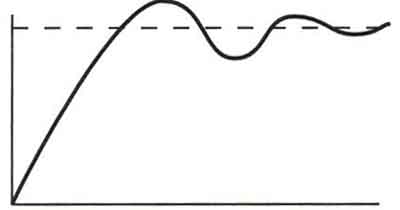AMAZON multi-meters discounts AMAZON oscilloscope discounts
Derivatives affect the calculation differently than simply being the inverse of integrals. In a PI controller, the integral action works well over the long term, as the amount of error is continually checked and the output is changed to bring the PV closer to the SP. If the gain happens to be rather large, the amount of the original change will be large and each time the integral action repeats this amount of change the controller will change the output in larger increments. This has the effect of possibly causing the PV to overshoot the SP, as shown in the Figure below. From this figure one can see that the PV overshoots the SP on the first oscillation but the controller reduces the amount of overshoot on each succeeding oscillation. This type of response is called quarter-amplitude decay because it reduces the error in four amplitudes. The reason the overshoot occurred is that in the PI formula, the controller does not know that the PV is larger than the SP until it happens. This would be similar to driving your car and looking out the side windows for stop signs. One would not know that you were at a stop sign until you were passing it.

Above: Graph of quarter-amplitude decay (QAD) response.
Derivative action performs the function of looking ahead or anticipating. The derivative action causes the controller to determine that if the output continues at the same level, the controller response will cause the PV to overshoot the SP. Since the controller now knows (anticipates) that the present output will likely cause the PV to overshoot the SP, the derivative action will cause a small amount of value to be subtracted from the offset (bias term), which will cause the output to become smaller.
Using derivatives does have some drawbacks. If the sensor signal (PV) has any noise in it, this noise will show up on top of the normal signal. When this occurs, the derivative function sees the increase in the signal from the noise as normal and it tries to adjust the response accordingly. The result of this action is that each time noise is encountered, even if it's only for a millisecond, the derivative will adjust the output as though the noise on the signal was the original signal. This causes the output to be very rough and it means that if the derivative is used in a controller application, the sensor signal must be filtered.
PREV: Rate Action
NEXT: Proportional and Derivative Control (PD)